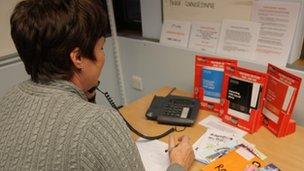Can child porn users be treated?
- Published

Sex offenders' home internet use can be monitored by the police via a new computer programme
A child protection charity says it is impossible to catch every person who looks at indecent images and more needs to be done to stop people from looking at them.
It comes as research by BBC News has found that the number of detected crimes of accessing illegal images has increased by 48% in four years.
But what impact can these images have and what can be done to stop people looking at them?
"Offenders are not normally heartless people," says Donald Findlater from child protection charity the Lucy Faithfull Foundation, which works with sexual offenders and organisations to help prevent abuse.
The foundation runs a helpline and educational treatment programme for people who have accessed images to talk about what they have done, the implications their actions have on children and how they can prevent it happening again.
Counsellors make the men work out why they looked at the images and confront them over whether they do have a sexual attraction to children.
And they are finding that an increasing number of people are using their services.
The detected crime figures, obtained under a Freedom of Information Act, show that in 2007, 919 crimes for were detected by the police however in 2011, this had risen to 1,362.
And a report by the Child Exploitation and Online Protection centre (Ceop), external has warned that an increasing number of people are looking at indecent images of children.
It said the number of cases referred to it had increased by 181% in a year, however it does not know how many people looked at these images because it is a grossly under-reported crime.
Mr Findlater believes making offenders understand the human cost of their actions can help to stop them seeking out images of abuse.
Men who look at these images are normally put in touch with the charity at the point of arrest, however anyone can volunteer to go on the course or call the helpline.
'Ingrained habit'
One person who has been on this programme is John - whose name has been changed - who was convicted of possessing 5,000 indecent images of children.
He received a two-year suspended jail sentence, attended an official sex offender treatment programme and was put on the sex offenders register.
On a personal level, his best friend of 30 years disowned him.
"I feel really, really bad about it and I wish that I'd been a different sort of person and not done it. But having done it and been convicted I'm determined to turn my life around and be as positive as I can," he said.
He said he became addicted to legal pornography when he was a teenager.
"I suppose that's not uncommon for teenage boys, but I carried on using it. That continued throughout adult life and I got to a very, very ingrained habit of buying pornography and using it.
"Some might say you get addicted to it, and in a way I think I was. I could have chosen to stop using it but I didn't, I carried on."
He says his obsession meant he was looking at all types of images which were becoming more and more extreme - and the internet enabled him to do this.
Mr Findlater said the majority of men that he had dealt with had started looking at images in this way.
"What they've done may never develop into a sexual interest. The majority of men would say they were viewing adult pornography and then started looking at things on the edge and that's how they ended up with it."
John said he "didn't appreciate what happened to the children for them to be in that position".
"The children are portrayed often smiling and happy and a lot of the images are them posing and I did not consider the surrounding circumstances.
"It's only when I got out of all of this and I got help that I was able to empathise with what was going on there and these children were clearly not consenting," he said.
'Abuse rings'
Dr Jon Bird, from the National Association for People Abused in Childhood (Napac) who was himself abused when he was a child, said producers of these types of images blank out the surroundings to hide clues and minimise the risk of discovery by authorities.
He said it also made it easier for the viewer to see the child as an object, and it was easy to make a child smile with sweets or flattery.
"It is very common for users of pornography to see images that they find stimulating and not think of the people in the images as individuals with human rights and feelings."
"It is like being raped again and again every day," said Dr Bird.
"To know that perverts are looking at these images adds to the difficulty of recovery which can last long into adult life.
"Some survivors know that the images are passed around and traded in abuse rings.
"This fact can also be used by perpetrators to make it harder for survivors to go to the police or seek therapeutic help because the perpetrators threaten to make the images more public and put the survivor's name in the public domain as well as the images."
And once the images start to be distributed on the internet, there is no way of ever being sure they have been completely removed.
"This leads to a permanent state of worry about the possibility of being recognised or associated with having been abused," added Dr Bird.
Prevention
Although the internet, and in particular social media, has made it easier to catch people who download these types of images, it has also made access to pornography much easier than it was before.
Mr Findlater said before the internet, this type of offending was less of a problem because it was riskier and cost more to gain access to these types of images.

The charity runs a helpline to help prevent people looking at images
According to Mr Findlater, the "volume of viewers is far larger than we can ever arrest" so prevention is imperative.
He said the best way of preventing this type of abuse happening was for offenders to be integrated into a community so they were not left alone with their thoughts. They therefore had more to lose by re-offending.
In John's case, the support of his wife Suzanne was vital.
Suzanne said she decided to stay with him as she thought "it was worth seeking help and advice".
"There's probably quite a few people out there who are judging me for staying with him, even people who I work with but they don't say anything.
"If that question did arise, I would say it's just been a bad experience."
Suzanne has also attended a counselling programme with the Lucy Faithfull Foundation which she said was "immensely helpful".
"I don't think this will happen again because we've talked about it and I don't think I would be in the relationship if it did happen again and he's fully aware of that. I couldn't go through this again," she said.
Mr Findlater said the charity was working with the police to establish what the re-offending rate was, however, from anecdotal evidence, people who have attended the course have not re-offended.
"Offenders will diminish in their heads what they've done. They have to feel distress for what they've done so that they can understand the role of their sexual fantasies - and know that sexual fantasies of children are not OK."
- Published23 February 2013
- Published14 June 2012
- Published13 June 2012
- Published21 December 2011
- Published25 July 2011
- Published13 June 2011
- Published31 May 2011